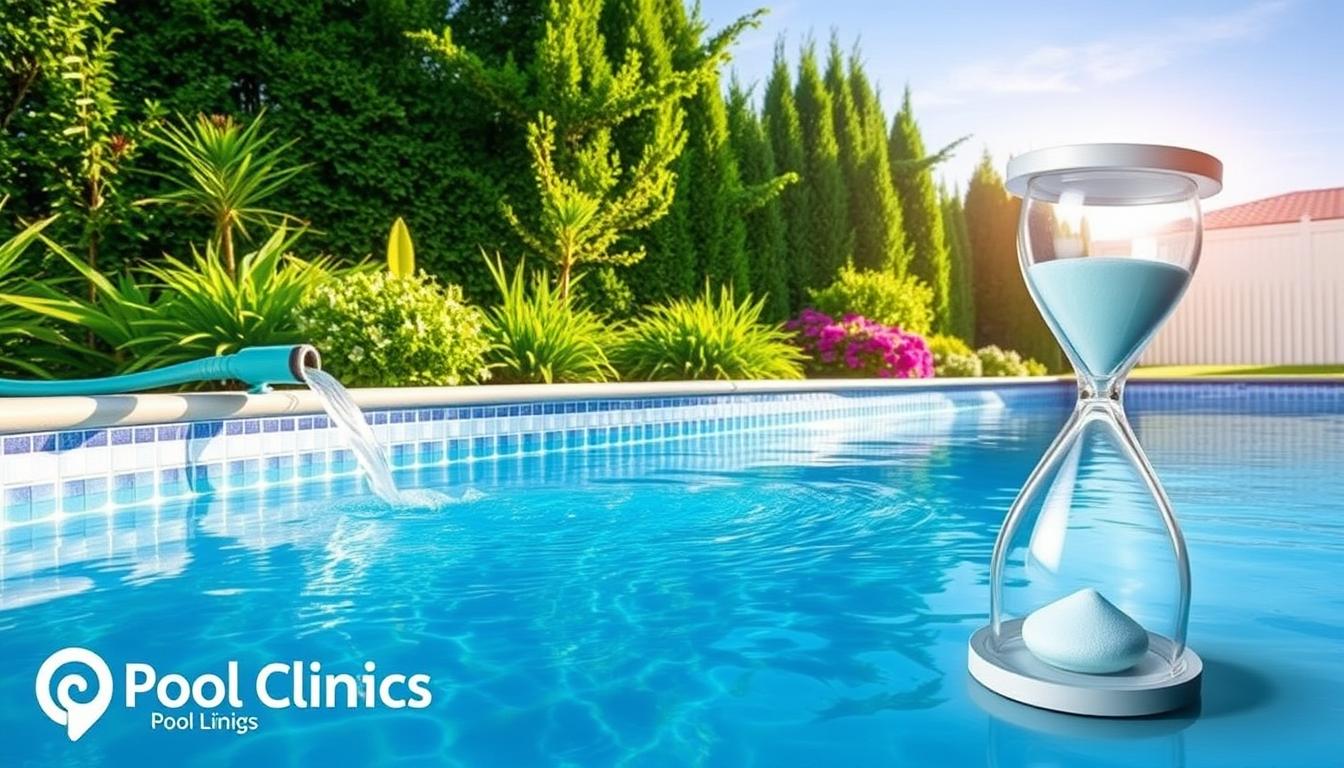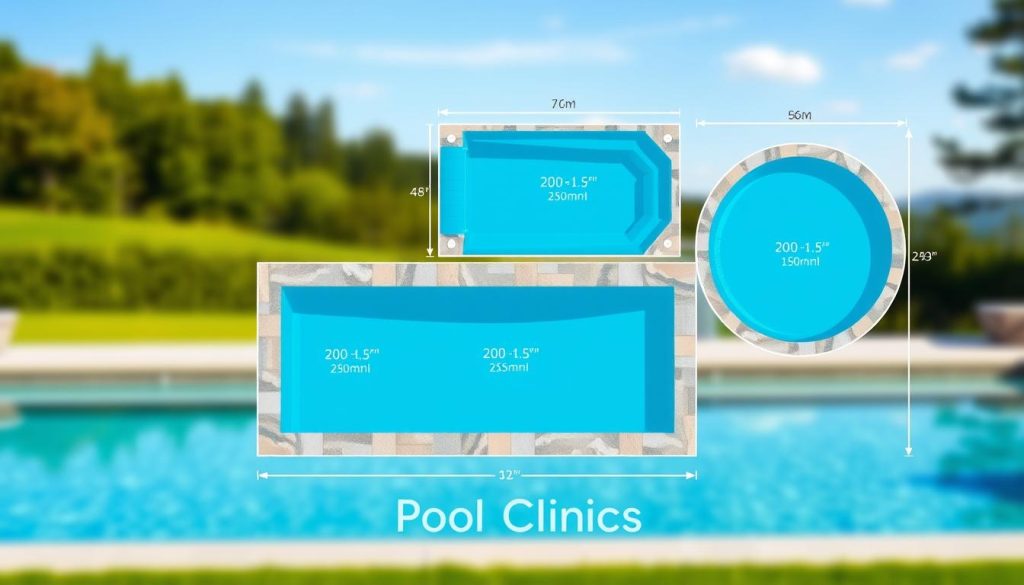
Summer’s coming, and we’re excited to jump into cool pools. But first, we need to fill them up. How long does this take? It depends on pool size, water flow, and source.
This guide will help you estimate your pool filling time. We’ll explore the factors that affect it. You’ll be ready to plan your summer activities and budget accordingly.
Filling a pool is an exciting process. It’s fun to watch the water level rise. And it’s thrilling to take that first swim. Let’s dive into the details of pool filling.
Key Takeaways
- The time it takes to fill a pool depends on pool size, water flow rate, and water source.
- An average-sized 15,000-gallon pool takes about 24-48 hours to fill using a garden hose.
- Well water may take around 72 hours to fill a 15,000-gallon pool.
- Larger pools like a 25,000-gallon pool can take 18 hours or more to fill.
- The cost to fill a pool ranges from $40 to $2,000, with an average cost of $4 to $10 per 1,000 gallons from a garden hose or $30 to $100 per 1,000 gallons from a pool water delivery service.
Factors Affecting Pool Filling Time
Several factors impact how long it takes to fill a swimming pool. Knowing these factors helps you plan better for filling your pool. Let’s explore the main elements that affect pool filling time.

Pool Size and Capacity
The size and capacity of the pool greatly influence filling time. Larger pools need more water and take longer to fill. Pool dimensions directly affect the total water volume required.
An average inground pool holds 15,000 to 20,000 gallons of water. This takes much longer to fill than a small above-ground pool with 3,000 gallons.
Water Flow Rate and Source
Water flow rate is crucial in determining filling time. It’s measured in gallons per minute (GPM) or gallons per hour (GPH). Higher flow rates mean faster filling.
The ideal flow rate for filling pools is about 600 gallons per hour. Municipal water sources usually have higher flow rates than well water systems.
Did you know that using well water to fill your pool can offer cost savings and eliminate the need for added chemicals found in municipal water sources?
Hose Size and Length
Hose size and length affect filling time too. A larger diameter hose allows more water flow. Longer hoses may reduce flow due to increased resistance.
Common garden hose sizes include:
- 1/2-inch diameter
- 5/8-inch diameter
- 3/4-inch diameter
A larger diameter hose can significantly reduce filling time. Make sure your water source and pool filter pump can handle the increased flow rate.
| Hose Diameter | Flow Rate (GPM) | Time to Fill 10,000 Gallons |
|---|---|---|
| 1/2-inch | 9 | 18.5 hours |
| 5/8-inch | 14 | 11.9 hours |
| 3/4-inch | 23 | 7.2 hours |
Understanding pool size, water flow, and hose size helps estimate filling time. This knowledge lets you optimize the process and enjoy your pool sooner.
How Long Does It Take for a Pool to Fill Up?
Filling a pool is exciting, but it’s crucial to know how long it takes. The time varies based on pool size, water source, and filling method.
Let’s explore the average filling times for different pool sizes. Understanding these factors helps you plan and enjoy your pool sooner.
Average Filling Time for Different Pool Sizes
Pool filling time depends on its size and capacity. Here’s a breakdown of average filling times for various pool sizes:
- Small above ground pool (3,000 gallons): 12-24 hours
- Large above ground pool (6,000 gallons): 24-48 hours
- Small inground pool (6,000 gallons): 24-48 hours
- Large custom inground pool (20,000 gallons): 80-160 hours
Larger pools take longer to fill. Custom inground pools can take several days to fill completely.
Filling a Pool with a Garden Hose
Garden hoses are common for filling pools. A standard hose flows 9-17 gallons per minute, depending on water pressure and hose size.
At this rate, a 10,000-gallon pool would take about 10-18 hours to fill. Using a hose for long periods can impact your water bill.
Filling a 10,000-20,000 gallon pool with municipal water costs $40 to $200. The price depends on local water rates.
While well water is a cost-free alternative, it may have higher levels of minerals and metals that can stain the pool or cause filtration issues. It’s also important to monitor the well’s capacity to avoid running it dry during the filling process.
Using a Water Delivery Service
Water delivery services like Water Runner offer a quick pool filling solution. They can fill large pools in hours, not days.
These companies use tanker trucks to deliver pre-treated water. The water is often filtered to remove impurities, ensuring a clean swimming environment.
| Pool Size (Gallons) | Garden Hose Filling Time | Water Delivery Service Filling Time |
|---|---|---|
| 6,000 | 6-11 hours | Less than 1 hour |
| 10,000 | 10-18 hours | Less than 1 hour |
| 20,000 | 20-36 hours | 1-2 hours |
Water delivery services are pricier than using a hose. They cost $200 to $600 per 6,000-gallon truckload.
However, they save time and offer efficient pool filling. Some companies even provide pre-chlorinated water, saving you an extra step.
In the end, pool filling time depends on size, water source, and filling method. Knowing these factors helps you plan and enjoy your pool faster.
Conclusion
Pool filling time depends on size, water capacity, flow rate, and water source. Using a garden hose takes 12 to 160 hours. Water delivery services are faster but costlier.
Regular pool maintenance is vital for optimal water quality. This includes monitoring chemistry levels and brushing the pool surface. Following National Plasters Council guidelines helps maintain the pool surface’s integrity.
Consult a local pool professional for personalized recommendations. They can assess your situation and suggest the best filling method. Understanding these factors ensures a safe, enjoyable pool for years.







